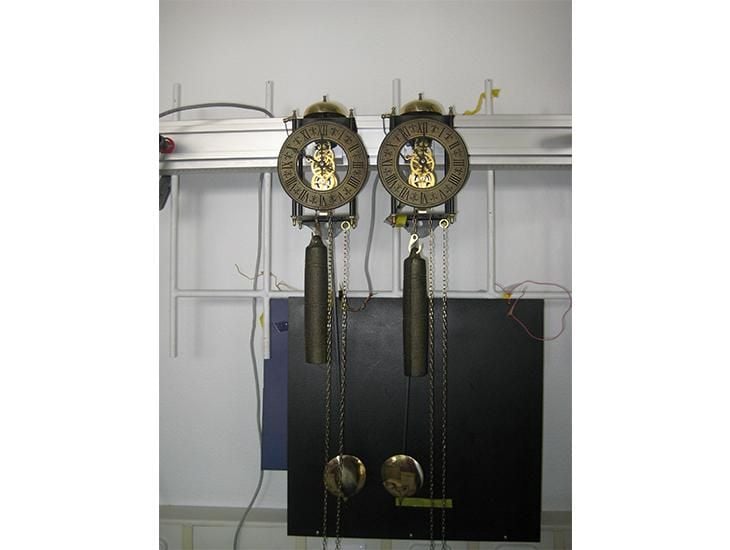Can Sound Explain a 350-Year-Old Clock Mystery?
Lab experiments suggest that a strange synchronization of pendulum clocks observed in the 1600s can be chalked up to acoustic energy
/https://tf-cmsv2-smithsonianmag-media.s3.amazonaws.com/filer/70/e7/70e7551c-631c-468c-9c7a-7b7026fde8c1/istock_000000281191_medium.jpg)
Christiaan Huygens was a busy scholar. Among his many achievements, the Dutch scientist figured out the shape of Saturn's rings and discovered that planet's largest moon, Titan. He founded the theory that light travels as a wave, and he invented the pendulum clock. Huygens, it seems, couldn't even turn off his scientific mind when he was under the weather.
In 1665 he was ill and stuck in bed, watching two pendulum clocks that were attached to a beam in his house. He noticed the pendulums started to swing in time with each other, no matter whether the clocks had been started or stopped at different times or what position the pendulums started in. Huygens was baffled. There had to be some way the clocks "spoke" to each other, but he lacked the precise instruments necessary to measure interaction between the clocks. So he chalked it up to mysterious movements transmitted by the air or the physical connection in the beam, and there the matter rested for more than 300 years.
Now, physicists revisiting the 17th-century conundrum think the answer may lie in sound waves. Henrique Oliveira and Luís V. Melo at the University of Lisbon recreated the conditions Huygens observed, then used extremely sensitive instruments to measure the variables. Their results, published this week in Scientific Reports, suggest that sound energy from the ticking clocks travels through the material connecting them and causes them to synchronize.
Previously, other scientists took a crack at the experiment using a beam that was allowed to move. In those models, the energy that makes the clocks sync up is from the conservation of momentum. Oliveira and Melo wanted to test a different model that would be more like the one Huygens was working with. They also wanted to be more precise than previous attempts.
They first used a computer to simulate the clocks, assuming that the clocks were connected by a stiff material. Then they attached two real pendulum clocks to an aluminum beam. They set the clocks ticking, and measured the periods of the pendulum swings with high-precision optical sensors. Sure enough, the pendulums would start to move in synch. Even if they moved in opposite directions, they would still swing with the same period.
"We tried different beam materials and conditions and could only get coupling when the [fixed] beam was made of a very good sound conductor, the clocks were close, and the frequencies were close enough," Melo says in an email.

So what is happening? It has to do with how pendulum clocks work. A pendulum swings, and an anchor, so named because of its shape, releases the teeth of a gear, which is attached to a descending weight. As the gear is released, the weight pulls it downward so it starts to rotate, but the anchor of the pendulum re-catches the teeth of the gear. As the pendulum swings back, it releases the gear again, and this time the anchor catches the other side. Meanwhile, the teeth of the gear slide under the anchor, pushing it and adding a little nudge to keep the pendulum swinging. There are lots of variations on this design, but that's the basic principle.
In the latest experiment, all this movement causes a small amount of sound energy to travel into the aluminum bar. Each time that energy pulse travels, it tends to push one clock's pendulum in time with the other. The experiment takes up to 18 hours or even days to run, because the clocks synchronize slowly. Melo notes that Huygens' clocks had 50- or 60-pound stabilization weights, whereas the ones in his experiment were a pound or less, so the forces Huygens' clocks transmitted were larger.
Even so, you could theoretically run the same experiment at home. "If you can find a good enough sound conductor for a beam … and if you are very patient, then you will get the conditions for coupling," Melo says. "But you will only be sure if you run an automated experiment. It's impossible to look continuously for days—it is mesmerizing, but one gets very anxious after a while."
Jonatan Peña Ramirez, a researcher at the Technical University of Eindhoven in the Netherlands, has also published studies of the Huygens' clock phenomenon. He says physicists like to study this system because it mimics other cycles in nature. "Similar phenomena can be observed in biological systems, where some cycles inside the human body may synchronize in a natural way," he says.
However, he isn't yet convinced that sound energy is the culprit for the clocks. "If you replace the driving mechanism in the clocks by a smooth mechanism, i.e., a mechanism that does not apply [discrete] impulses to the clocks, still one can be able to observe synchronization," he says. As far as he's concerned, "Huygens' synchronization … is far from being solved."